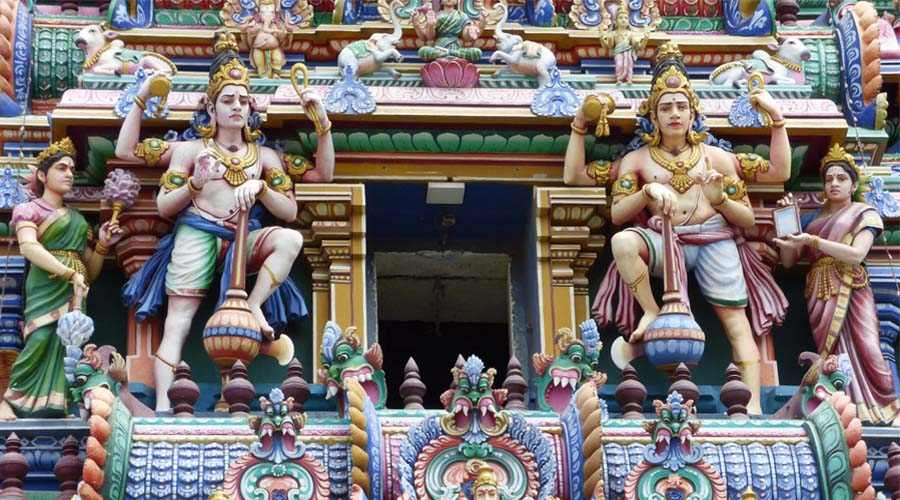Kurinji Andavar Temple is a unique and spiritually significant Hindu temple nestled in the serene hills of Kodaikanal, Tamil Nadu. Built in 1936 by Lady Leelavathi Ramanathan, a European woman who embraced Hinduism, the temple is dedicated to Lord Murugan, revered as the “God of the Hill” or Kurinji Andavar. This temple stands out not only for its rich religious significance but also for its close association with the rare Kurinji flower that blooms once every twelve years in the surrounding hills, lending the temple its sacred name and picturesque setting.
Historical Background and Founding
The foundation of Kurinji Andavar Temple is an inspiring story mingling spirituality, cultural integration, and devotion. Lady Leelavathi, originally of European descent, was deeply moved by Hindu philosophy and scriptures. After converting to Hinduism and adopting the name Leelavathi, she married Ponnambalam Ramanathan, the former Solicitor-General of Sri Lanka. Following the demise of her husband, she constructed the temple in 1936 to honor Lord Murugan and commemorate her late husband’s memory. Her devotion and the ensuing construction of the temple mark a significant event where a foreign-born devotee embraced Indian spiritual traditions fully and contributed a lasting legacy.
Spiritual Significance of Lord Murugan and the Temple
Lord Murugan, to whom the temple is dedicated, holds immense importance in Tamil Hindu culture. Known as the God of War and the protector of hills and mountains, he is affectionately called “Kurinji Andavar,” which means “God of the Kurinji flower.” The Kurinji flower itself is a rare botanical marvel, scientifically named Strobilanthes kunthianus, that blooms only once every twelve years, covering the hills around Kodaikanal with a vibrant purple-blue carpet. This rare phenomenon aligns spiritually with Lord Murugan’s association with the hills, enhancing the temple’s mystical aura.
The temple serves as a sanctuary where devotees find deep peace and spiritual solace. The atmosphere, attributed to both the deity’s power and the natural surroundings, turns the temple into an ideal meditation and prayer site. Lord Murugan’s presence as the divine protector of these hills is felt by many visitors, often bringing a sense of calm and blessing.
Architecture and Location
Located approximately 3 km from the iconic Kodaikanal Lake, the Kurinji Andavar Temple exhibits classic South Indian Dravidian architectural style. It features intricately carved pillars, vibrant murals depicting Hindu mythology, and beautifully designed shrines, reflecting traditional craftsmanship. The temple’s structure harmonizes with the lush green backdrop, enhancing its spiritual and aesthetic appeal.
The temple’s location on a hill offers breathtaking panoramic views of the surrounding natural beauty, including sights of the Palani Hills and the Vaigai Dam. This scenic setting, coupled with the sacred atmosphere, makes it a favored destination not only for pilgrims but also nature enthusiasts and tourists.
Kurinji Flower and Cultural Importance
The Kurinji flower holds a special cultural and religious importance in the region. Blooming once every twelve years, it blankets the hills with a spectacular purple hue, attracting visitors and botanical enthusiasts worldwide. The timing of this bloom is still a subject of fascination and mystery for scientists and locals alike, with intervals of 3, 7, 12, 17, or 36 years observed for different varieties of the flower. This natural cycle has woven the Kurinji flower into the religious fabric of the region, amplifying the temple’s symbolic power as the home of the “God of Kurinji”.
Local traditions also believe that honey harvested during the flowering season has medicinal properties, adding to the ecological and cultural richness around the temple. This intersection between nature and spirituality makes the temple a unique pilgrimage spot where divine worship and natural wonder coalesce.
Tourism and Pilgrimage
Kurinji Andavar Temple is a significant spiritual and tourist destination in Kodaikanal. Its unique history, stunning architecture, the rarity of the Kurinji flower, and its panoramic views draw visitors year-round. The temple hosts many Hindu festivals, with devotees thronging especially during Murugan festivals, and in years when the Kurinji flower blooms, attracting crowds eager to witness this natural spectacle.
In recent years, as Kodaikanal has gained popularity for eco-tourism and adventure activities like trekking, the temple’s serene setting provides a spiritual contrast and complement to more active tourist pursuits. Visitors often combine the temple visit with hikes around the hills, enhancing their connection to nature and spirituality.
The temple operates daily with free entry, welcoming pilgrims, tourists, and nature lovers alike. The region strives to maintain sustainable tourism practices to preserve the temple’s tranquility and the delicate ecosystem of Kodaikanal’s hills.
Conclusion
Kurinji Andavar Temple is much more than a religious shrine; it is a symbol of cultural blending, nature worship, and spiritual peace. Founded by a devoted European convert, the temple honors Lord Murugan, the divine protector of the hills, with a strong identity linked to the rare Kurinji flower’s mysterious twelve-year bloom. Its architectural beauty, peaceful environment, and breathtaking views make it a must-visit place in Kodaikanal, offering visitors both spiritual enrichment and a deep appreciation of nature’s wonders.

